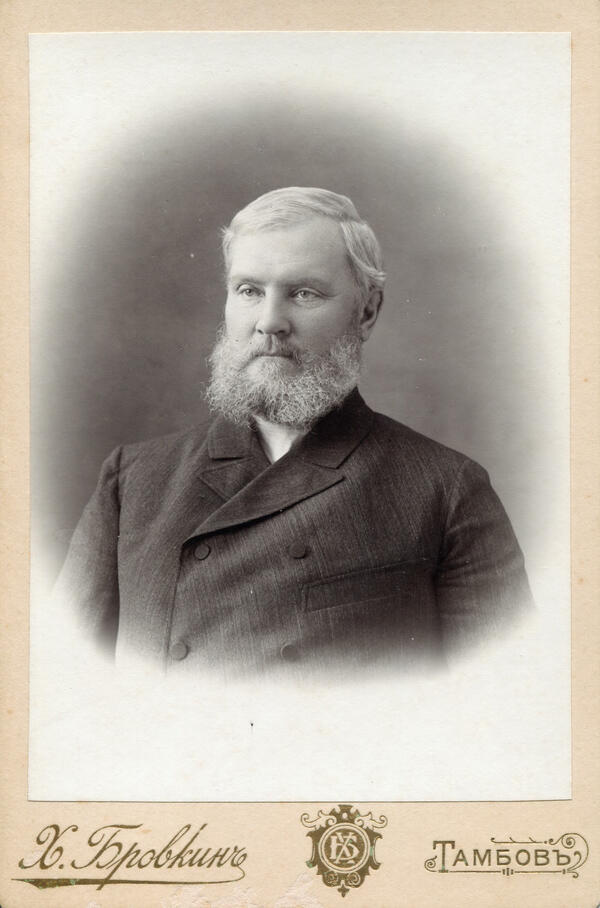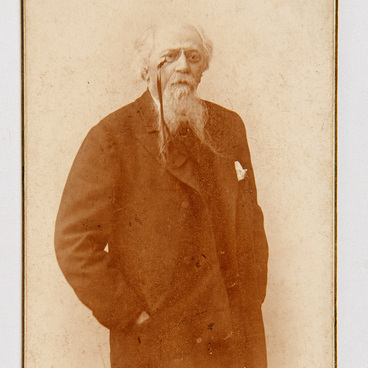Mikhail Andreyevich Zaveryachev served as the manager of the Boratynsky estate in Ilyinovka, Kirsanovsky District, from 1880 to 1917. The photo of M. Zaveryachev in the Kirsanov museum probably is taken probably in the early 20th century.
1 / 2
Photograph of M.A. Zaverachev
Creation period
the early 20th century
Place of сreation
Kirsanovsky District, the Russian Empire
Dimensions
16,5x11 cm
Technique
photography
Collection
2
Open in app#2
#10
And we were all called ‘dvornya’, probably from the word ‘dvor’ (court in Russian), ‘courtiers’. The manor house was like a king’s palace, the center, and we, the people around it, were the court.
The godson of M. A. Zaveryachev, Metropolitan Veniamin (born Ivan Afanasievich Fedchenkov), a native of Ilyinovka, wrote in his memoirs
#6
The memoirs of Metropolitan Veniamin reveal that there was a hierarchy among the household servants. The lowest position was held by the shepherd. The most privileged group included the housekeeper, gardener and majordomo, while the most privileged group were the “administrators”: the steward (obyezhchik), the clerk and the steward (burmister). The estate manager was in charge of all economic affairs and had an exceptional position of proximity to the “masters”.
The black and white photograph from the Kirsanov Local History Museum depicts M. A. Zaveryachev late in his life. Judging by the inscription on the cabinet card, the photograph was taken in the photo studio of Khrisanf Danilovich Brovkin, located on Bolshaya Street in Tambov. At that time the owners of photographic institutions had to abide by the trade regulations and Oberpolitsmeister. Photographic workshops were subject to the general rules for printing houses, that is why the Print Law of April 6, 1865 applied to all the photographic workshops in Russia. Their owners were obliged to put their name and address on the products. Cabinet cards or stamps were used for that purpose. All photoproducts were subject to censorship and two copies of each photograph were left at the photographer’s studio for submission to the policeman.
Although prices for photographic services had become more affordable by the early 20th century, only the well-to-do could still afford to have their pictures taken to keep them as souvenirs. The demand for such services, however, continued unabated, as the fashion for photography flourished.
It was common practice to be photographed in photo studios in order to present a picture of oneself to those close to one’s heart. Mikhail Andreevich Zaveryachev probably visited Brovkin’s photo studio when traveling to Tambov on business, although his son, Vladimir Zaveryachev, was an amateur photographer and captured his father more than once in Ilyinovka.
The black and white photograph from the Kirsanov Local History Museum depicts M. A. Zaveryachev late in his life. Judging by the inscription on the cabinet card, the photograph was taken in the photo studio of Khrisanf Danilovich Brovkin, located on Bolshaya Street in Tambov. At that time the owners of photographic institutions had to abide by the trade regulations and Oberpolitsmeister. Photographic workshops were subject to the general rules for printing houses, that is why the Print Law of April 6, 1865 applied to all the photographic workshops in Russia. Their owners were obliged to put their name and address on the products. Cabinet cards or stamps were used for that purpose. All photoproducts were subject to censorship and two copies of each photograph were left at the photographer’s studio for submission to the policeman.
Although prices for photographic services had become more affordable by the early 20th century, only the well-to-do could still afford to have their pictures taken to keep them as souvenirs. The demand for such services, however, continued unabated, as the fashion for photography flourished.
It was common practice to be photographed in photo studios in order to present a picture of oneself to those close to one’s heart. Mikhail Andreevich Zaveryachev probably visited Brovkin’s photo studio when traveling to Tambov on business, although his son, Vladimir Zaveryachev, was an amateur photographer and captured his father more than once in Ilyinovka.
#8
Ministry of Culture of the Russian Federation
read morehide
00:00
00:00
1x
Photograph of M.A. Zaverachev
Creation period
the early 20th century
Place of сreation
Kirsanovsky District, the Russian Empire
Dimensions
16,5x11 cm
Technique
photography
Collection
2
Open in app
Share




